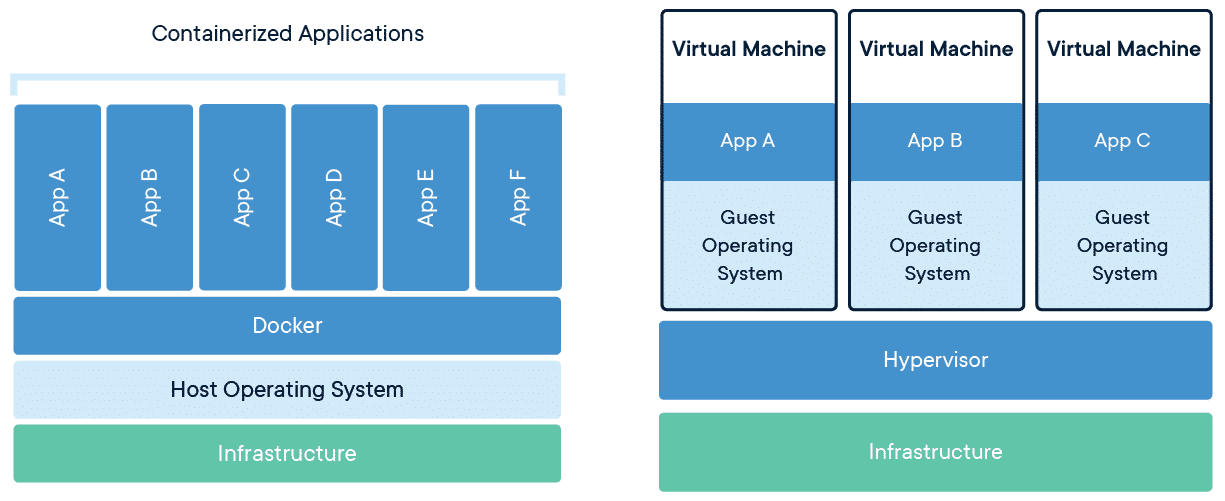Docker Containers
Detailed explanation about containers and why should you use them
Website Visitors:Containers allow software developers to build, run and manage applications efficiently from one place. They allow you to easily create isolated environments so that you don’t accidentally kill or corrupt data. Containers give you the flexibility to run multiple apps side by side without worrying about conflict. Containers are not just for developers anymore. Learn more about containers in this article.
Containers have been adopted by industry leaders. Containerization is the process of creating self-contained packages that allow applications to be easily deployed, updated, and scaled.
-
What exactly is containerization?
Containerization is nothing but a bundle of all your application code and its dependencies into a single package called a container, which runs on any infrastructure. With containerization, developers can create and deploy applications much faster and easily.
-
What’s wrong with using a VM or the traditional way ?
In a traditional environment, code is written in a specific environment (like a developer’s laptop or a VM) and then moved to the actual application servers. This could result in bugs and errors as the configuration environment will not be the same for the developer’s device and the actual app servers. Also, VMs use more resources when deployed for running the application, but containers use a lot fewer resources when compared to VMs.
-
How does containers/containerization solve this issue?
Containerization resolves this issue by bundling the application code along with all other dependencies like config files and libraries that are required for it to run. This package is called a container, which is abstracted from the OS, which makes it portable to run in any environment. Containers can be deployed very quickly and more securely.
Containers are lightweight, which means they use the same host machine’s kernel and resources. They do not need additional OS or resources to run the application every time. Containers are very small in size when compared to a VM and need very little, or sometimes no, delay in starting the application. With containers, you do not have to deploy multiple VMs, ending up with more resource usage and licensing costs for the VMs.
Benefits of containers
-
Portability: As containers create a complete package (explained above) with all the dependent services for an application, they are very portable and can run on any platform.
-
Speed: Containers can be deployed very quickly as they do not need a separate VM or any other dependencies to start. They use the same machine’s resources, which results in fewer VM creations, which in turn saves licensing costs. As there is no separate OS to boot, containers are quick to deploy.
-
Isolation: Every container/containerized application works independently. So, if one container fails, it will not result in the failure of other containers. Developers can work on that failed container alone and fix it.
-
Agility: As containers are quick to deploy and terminate, they can also be integrated with existing DevOps tools. Efficiency: As they do not need separate resources to run, and they are very smaller in capacity than a regular VM, more containers can be deployed on the same machine when compared against a single VM’s compute capacity.
-
Easy to manage: Containers are quick to deploy, upgrade, rollback, and terminate.
-
Security: As containers work independently in an isolated environment, any injection of malicious code into one container will not affect other containers.
What is Docker
Docker is an open source platform that allows users to create their own lightweight virtual machines. You can use these lightweight VMs to deploy and run apps on a single host or across multiple hosts.
Docker is a software using which developers can build, test and deploy containerized applications quickly. Docker has its own website with all the predefined containers. When you run docker command with an image name, it checks if that image is available locally on your machine. If it is available, docker creates a container from it. If not, it will download the image from internet. More about docker in upcoming articles.
Comparison between Containers and VM

Suggested article
Now that you know about Containers and its uses, continue reading our other article: Docker Definitions here. All other DevOps categories are listed here: DevOps Tools. Have a look at the posts as per your topic of interest.
Conclusion
In this tutorial, we’ve explained about containers and their uses. We’ve also demonstrated examples for all the topics that are discussed. We hope you have learned something new in this article.
Please feel free to share your thoughts about this article in the comments section below.
Your inbox needs more DevOps articles.
Subscribe to get our latest content by email.
